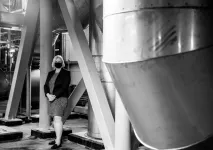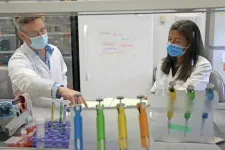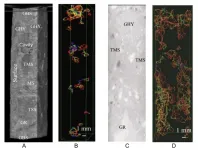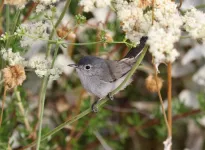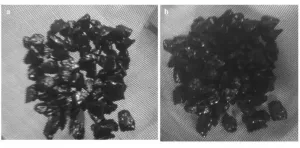(Press-News.org) A group of the world's leading experts in the transmission of airborne pathogens is calling for a tightened regulatory system to control air quality in buildings - as a way of reducing the spread of covid-19 and other illnesses.
Writing in the journal Science, the 40 scientists say: "A paradigm shift is needed on the scale that occurred when Chadwick's Sanitary Report in 1842 led the British government to encourage cities to organise clean water supplies and centralised sewage systems.
"In the 21st century we need to establish the foundations to ensure that the air in our buildings is clean with a significantly reduced pathogen count, contributing to the building occupants' health, just as we expect for the water coming out of our taps."
The scientists who have contributed to the analysis include Cath Noakes, Professor of Environmental Engineering for Buildings at the University of Leeds and a member of SAGE, the body that advises the UK Government on scientific emergencies.
Professor Noakes said: "Over the years, we have neglected the role that the air circulating inside a building plays in the way germs and viruses may spread between people. The pandemic has exposed that deficiency in our understanding and the way we seek to make buildings safer to use.
"We need to introduce new mechanisms that keep pathogen levels in the air flow in buildings and other enclosed spaces to a minimum. That approach can be achieved with technology backed-up with a requirement to meet new standards."
"Action to improve ventilation to reduce exposure to airborne pathogens will bring other benefits, including reducing exposure to other air pollutants and improved performance and wellbeing."
Recognising the risk of aerosol pathogen spread
Historically, public health regulations have concentrated on sanitation, drinking water and food safety, whereas the risk from airborne pathogens whether it is flu or covid-19 is "... addressed fairly weakly, if at all, in terms of regulations, standards, and building design and operation, pertaining to the air we breathe", say the scientists.
But research during the covid-19 pandemic has underlined the role that aerosols play in spreading disease. When a person who has a respiratory infection speaks, coughs or sneezes, tiny infective particles are emitted from their nose and mouth. Indoors, those tiny particles are carried in the air and infect other people.
The paper says: "... community outbreaks for COVID-19 infection in particular most frequently occur at larger distances through inhalation of airborne virus-laden particles in indoor spaces shared with infected individuals.
"Such airborne transmission is potentially the dominant mode of transmission of numerous respiratory infections. We also have strong evidence on disease transmission, for example in restaurants, ships, and schools, suggesting that the way we design, operate, and maintain buildings influences transmission."
That risk of people becoming cross infected inside a building can be reduced through ventilation coupled with air disinfection and air filtration systems. However, the scientists note: "... almost no engineering-based measures to limit community respiratory infection transmission had been employed in public buildings - excluding health care facilities - or transport infrastructure anywhere in the world."
Tighter controls
There are ventilation guidelines and standards which architects and builders must follow but the focus is on reducing odours and carbon dioxide levels and in maintaining thermal comfort. None provide recommendations on how to control the spread of pathogens.
The scientists are calling for World Health Organisation indoor air-quality guidelines, which cover pollutants such as carbon monoxide and other chemicals, to be extended to include airborne pathogens. The experts say individual governments need to introduce and enforce domestic regulations.
"None of this means that every indoor space should become a biosafety facility. It means that a building should be designed and operated according to its purpose and the activities conducted there, so that airborne infection risk is maintained below an acceptable level," the scientists write in the paper.
That would mean different standards for a gym where people may be breathing heavily as opposed to people relaxing in a cinema.
The lead author of the paper, Lidia Morawska, Distinguished Professor in the School of Earth and Atmospheric Sciences at Queensland University of Technology in Australia, said: "For decades, the focus of architects and building engineers was on thermal comfort, odour control, perceived air quality, initial investment cost, energy use, and other performance issues, while infection control was neglected."
Quotes from other authors of the paper
Trish Greenhalgh, Professor of Primary Care Health Sciences at the University of Oxford, said: " It's no exaggeration to call this a paradigm shift. Up to now, most of the efforts to prevent transmission of Covid-19 and other airborne respiratory diseases such as tuberculosis has focused on influencing individual behaviour such as mask-wearing, cough hygiene and handwashing. These measures are still important, but they will be relatively ineffective in the indoor environment until we ensure that the air we inhale contains far fewer particles that have been exhaled by others in the room.
"We need to re-think the practice, currently common in many countries, of keeping windows closed and recycling stale air in air-conditioning. Windows should be opened and draughty rooms welcomed; if air is recycled it must be filtered and disinfected; and monitoring air quality--for example using CO2 monitors--should become commonplace. In short, we need to re-think--and re-regulate--what counts as a 'healthy' building."
Stephanie Dancer, Professor of Microbiology at Edninburgh Napier University and Consultant Medical Microbiologist at NHS Lanarkshire, in Scotland, said: "Even just opening the windows provides more than a gesture towards reducing the risk of infection."
Costs
The scientists challenge the argument that costs of air quality control in buildings would be prohibitively expensive. They say the monthly cost of covid-19 is conservatively estimated at $1 trillion. Installing ventilation and air-quality systems designed to remove airborne pathogens would add about one percent to the construction costs of a typical building.
Improving air quality in buildings would bring benefits beyond reducing sickness levels due to respiratory infections. It is likely to reduce allergens and the number of people who experience 'sick building syndrome'.
INFORMATION:
Professor Noakes is a Fellow of the Institution of Mechanical Engineers, where she has been engaged with their COVID-19 task force supporting the engineering approaches to improving ventilation in buildings.
Epidemic. Pandemic. These terms have become second nature to us, popping up in everyday conversation, and for good reason -- COVID-19 is the latest pandemic to pose a threat to humanity.
But in recent months, far less attention has been paid to another widely spread problem that has been proliferating since the late 1970s: Lyme disease.
Lyme disease is the most reported vector-borne disease in the country. Over the past 20 years, the United States has experienced a dramatic increase in both the number of reported cases and the geographic distribution of the disease. In Virginia, the disease is transmitted by blacklegged ticks, which are infected with the Lyme disease-causing bacterium Borrelia ...
Scientists reveal that the deterioration of modern concrete and asphalt structures is due to the presence of trace quantities of organic matter in these structures.
Cement and asphalt are vital to modern construction materials; cement is used for the construction of various buildings and structures, while asphalt is primarily used for highways and runways. They have been widely used for these purposes since the 1800s. It has been observed modern concrete structures and asphalt structures tend to deteriorate much faster than historical structures, but the reason for this phenomenon was unknown.
A team of scientists from six institutions, including Akihiro ...
One-third of the water catchments included in a Victorian study had not recovered from a severe drought nearly eight years later, Australian-first research from Monash University shows.
Globally, science holds the common view that rivers and underground water supplies eventually replenish following periods of severe drought or flood.
This study, led by Dr Tim Peterson from Monash University's Department of Civil Engineering and published today in the prestigious international journal Science, is the first in the world to challenge this widely held view.
Researchers used statistical ...
A new approach to genomic species delineation could impact policy and lend clarity to legislation for designating a species as endangered or at risk.
The coastal California gnatcatcher is an unassuming little gray songbird that's been at the epicenter of a legal brawl for nearly 28 years, ever since U.S. Fish and Wildlife Service listed it as threatened under the Endangered Species Act.
Found along the Baja California coast, from down south in El Rosario, Mexico to Long Beach, Calif., its natural habitat is the rapidly declining coastal sagebrush that occupies prime, pristine real estate along the West Coast. When this particular gnatcatcher, Polioptila californica, was granted protection, the region's real estate developers went to court to get it delisted. ...
Viruses require the resources of an infected cell to replicate and then infect further cells, and transfer to other individuals. One essential step in the viral life cycle is the production of new viral proteins based on the instructions in the viral RNA genome. Following these construction plans, the cell's own protein synthesis machine, called the ribosome, produces the viral proteins.
In the absence of viral infection, the ribosome moves along the RNA in strictly defined steps, reading three letters of RNA at a time. This three-letter code defines the corresponding amino acid that is being attached to the growing protein. It almost never happens that the ribosome slips one or two RNA letters forward or backward instead of following the regular three-letter steps. When such a slip ...
Irvine, CA - May 13, 2021 - A new University of California, Irvine-led study finds low serum levels of the sugar N-acetylglucosamine (GlcNAc), is associated with progressive disability and neurodegeneration in multiple sclerosis (MS).
The study, done in collaboration with researchers from Charité - Universitätsmedizin Berlin, Germany, and the University of Toronto, Canada, is titled, "Association of a Marker of N-Acetylglucosamine With Progressive Multiple Sclerosis and Neurodegeneration," The study was published this week in JAMA Neurology.
The study suggests that GlcNAc, which has been previously shown to promote re-myelination and suppress neurodegeneration in animal models of MS, ...
First co-author, Junior Research Associate of the Rheological and Thermochemical Research Lab Richard Djimasbe, comments, "To obtain bitumen as a half-solid product from heavy oil, you have to extract light fractions, and the rest is non-oxidized bitumen. Because of the relatively low ratio of light fractions in heavy oil, it's a simple and cheap way of bitumen production. The method allows for rational use of both heavy oil and light oil."
Lab Head Mikhail Varfolomeev adds, "One of the priorities of our World-Level Research Center in Liquid Hydrocarbons is the use of heavy oils, which constitute the majority of reserves both in Russia and in the world. One of the most important parts of this is extraction and refining of heavy ...
Laura Riesenberg was visiting a local amusement park with three of her children when she suffered a massive heart attack.
"I was down for about 20 minutes and they defibrillated me twice on site, possibly three times," she says. "Obviously, I was unaware of it. I know from reading the reports what happened."
"I was extremely fortunate that someone found me within seconds of collapsing," says Riesenberg. "Had it happened anywhere else I wouldn't be talking to you right now. If I had been in the basement doing laundry, I would have been in trouble."
The 51-year-old Loveland, Ohio, resident ...
Pregnant Aussie mums are being denied access to medications which treat severe nausea and vomiting by pharmacists and medical practitioners because of misleading labels and a lack of awareness about clinical guidelines.
A new study surveyed 249 Australian women who suffered from severe nausea and vomiting during pregnancy (NVP) or hyperemesis gravidarum (HG) and examined their experiences in accessing medications during pregnancy.
One in four women reported being denied medications for NVP/ HG at some stage during pregnancy. This most commonly involved the over-the-counter medicine doxylamine and interactions ...
PHOENIX, Ariz. -- May 13, 2021 -- In the largest study of the associations between smoking and cardiovascular disease on cognitive function, researchers at the Translational Genomics Research Institute (TGen), an affiliate of City of Hope, found both impair the ability to learn and memorize; and that the effects of smoking are more pronounced among females, while males are more impaired by cardiovascular disease.
The results appear today in the journal Scientific Reports.
Previous attempts to quantify cognitive function among smokers and assess sex differences produced mixed results. The TGen researchers attribute this to the limited size of previous data sets. By ...
